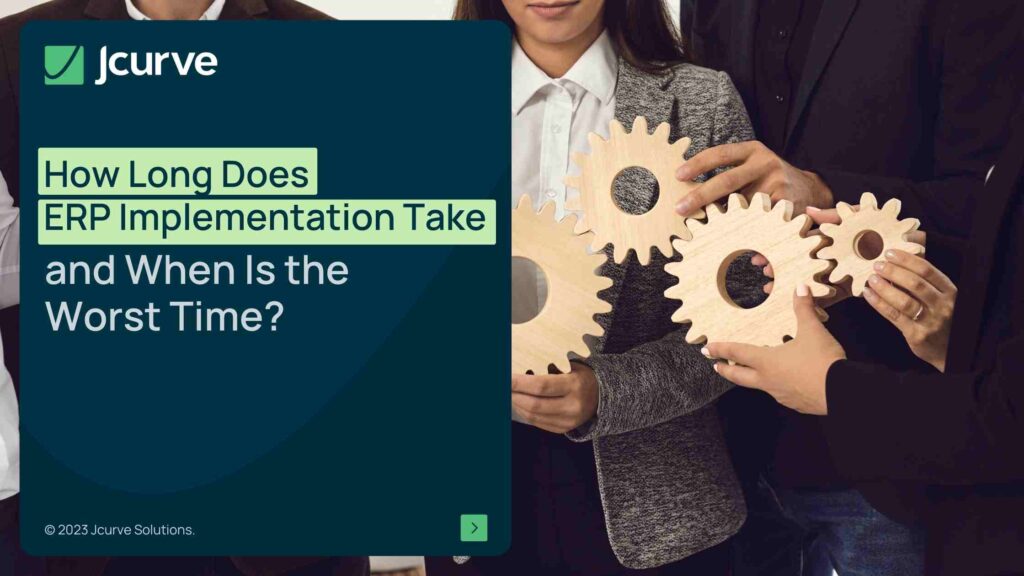Some surprises can make your day. Like when you find out the product you’ve been eyeing off for weeks has just gone on sale. Other surprises, however, can have the opposite effect. If you’ve been looking into ERP software to help manage your business more efficiently, you won’t want any surprises as you start planning for a successful ERP implementation.
Find out what to consider and start building a more informed ERP implementation roadmap. Get the insights on how long it’s likely to take and when are the worst times to get started with an ERP system implementation.

How long does an ERP implementation take?
Generally, there are no standard deadlines for an ERP implementation, but it normally takes 4 to 6 months, or sometimes even longer. It will always depend on many different factors such as:
• Size of the company
• Number of countries the company operates
• Employee headcount
• Current Organisation business process
• Expected number of users in the system
• The amount of information that needs to be integrated into the new ERP system
• Industry
• Complexity of the system being installed
The type of industry are processes also impact timelines. See how NetSuite configures across industries like manufacturing and retail.
Every business has different needs, but a typical implementation for small business software like JCurve ERP takes around 12 weeks with an Essentials Implementation. This type of implementation sets up core business functionality and lets you bring over essential data.
ERP systems like NetSuite provide functionality to address unique industry requirements. Learn about tailoring NetSuite to different verticals.
It’s possible to cut down this time-frame. Organisations with a straight-forward business model, the right team of staff available for the implementation project and cleansed data (including financials, suppliers, customers, inventory and orders)have been seen to go-live in little as four weeks. Start-up businesses that have less data to set up can also attract a much faster setup time.
Implementations with complex or custom requirements, as is often the case for larger businesses, can take least 3-6+ months from the date of order to go-live, depending on requirements.
What else can influence your ERP implementation timeframe?
- Getting the right internal resources involved and coordinated
- The time to gather information from your team on what issues you want to solve with a new ERP system
- Availability of your key staff and resources during the implementation
- Documenting your existing processes and identifying anything that needs changing
- Tidying up and data-cleansing of current business information and deciding what to bring over
When are the worst times to implement a new ERP system?
Too long into the future.
you’re already short of time and realising that multiple systems, manual record-keeping and slow processes are creating bottlenecks for your business, it’s easy to say, “I don’t have time for an ERP implementation right now.” But take a step back and think about it. If systems and processes are causing you more work, it’s only going to continue getting worse.
For many small businesses, it can feel like there’s never a perfect time to focus on ERP system implementation. But the sooner you undertake it, the sooner you can start saving yourself time, leveraging best-practice processes, and setting up automation that will cut down manual handling. Putting off an ERP implementation means putting up with the current pain for even longer.
Too close to the end of financial year.
Most companies implementing a new ERP system aim to start fresh in the new financial year. Why? From an accounting point of view, EOFY is a key date to get things closed off. Switching to a different system for the new financial year means doing only one lot of year end processing. If you were to change over months before or after EOFY, you may need to do an effective “year end” for your system change over, then another lot of actual year end processing at EOFY, bringing both sets of data together to produce your complete revenue year end reporting. Taking the opportunity to keep things simple with a new financial year switch-over can save you time and money from an accounting perspective.
When businesses aim for a new financial year change-over, many leave it too close to EOFY. Allowing at least 12 weeks before the new financial year can help you see a clean cut-over. That’s 12 weeks from when you commit to an ERP solution until go-live. When setting up software that will more efficiently manage your business, you don’t want to be taking any shortcuts or rushing to meet an unrealistic go-live date.
“When businesses aim for a new financial year change-over, many leave it too close to EOFY. Allowing at least 12 weeks before the new financial year can help you see a clean cut-over. That’s 12 weeks from when you commit to an ERP solution until go-live.”
When key staff are on holidays.
There will be people within your company responsible for deciding which data to cleanse, what to bring over to the new system, test, learn the system, and help others with using the new ERP system. You’ll want to ensure these key people are available throughout the implementation and know what’s happening at each step.
When engaging an ERP solution provider, let them know up-front about when key staff will be on leave. Your provider will help you formulate a plan using their project management software to work around any down-times and allow comfortable time-frames, milestones, and check-in meetings to help keep the project on track.
You’re company’s busiest historical periods.
Many organisations have seasonal fluctuations – periods where sales and demand are usually at their highest. These periods can be busy and stressful for your team, so try to plan around them if possible.
Part of the reason for considering ERP software may be to help you see a clear picture of seasonality and demand fluctuations. If you don’t have the reporting available to see it right now, ask your team when they feel are the peak times for the business.

Lessons others have learnt
Get everyone involved.
Right from the start, let your team know that you’re exploring new business management software solutions. Gather feedback on their individual pain points, what they think is working and what’s not. This can help shape discussions with ERP solution providers and crystallise what you need from an ERP system.
Don’t try to do everything at once.
If your ideal ERP system includes extended functionality like a barcode scanning solution for your warehouse, EDI transactions with suppliers and eCommerce integration from your website to your ERP, take a moment to think about a staged approach. Trying to do too much can overwhelm your staff who will be using the new system and push out your implementation time. Set a scope that’s based around your essential functionality and will let you see success quickly to then build on in subsequent phases.
To help simplify the process and make it easy to plan, your ERP solution provider should provide you with a statement of works outlining the core functionality covered in the initial implementation and work with you to map out the next phases.
Understand the variables.
There can be a range of factors which can drive ERP implementation time up or down. Cloud-based ERP solutions, for example, can save you time over on-premise solutions. With cloud-based deployment, there’s no server equipment or technical staff needed to set up and maintain systems. Conversely, some factors which can increase the setup time can include customisation of fields and forms to match existing processes, data cleansing that needs to be performed before getting started, or simply not having the right ERP solution provider to help you understand what you need to prepare.
On another note, it’s important to understand why some ERP implementations fail and how you can set your project up for success. Learn more about why ERP implementations fail and keys to success now.
“Right from the start, let your team know that you’re exploring new business management software solutions. Gather feedback on their individual pain points, what they think is working and what’s not.”
The beginning of the new financial year can be the perfect time for companies to implement a new ERP system. If you’re thinking about ERP software, start preparing early and give some consideration to:
• How long it may take to fulfil all your requirements
• The timing that’s going to be right for your business
• The valuable lessons learnt by others like setting the proper scope, getting your team involved, and variables you may need to account for
Before going into an implementation, start getting prepared and informed. Working with an experienced ERP solution provider means leveraging their tried and tested rapid implementation methodology and working with a team who has hundreds of hours of real-world experience. They can give you the right tools, pre-built templates, pre-defined roles and dashboards as part of your implementation to speed up the process and reduce business disruption. This all works to remove any surprises and help you see a successful ERP implementation even faster.









